Are you a Quiet Speculation member?
If not, now is a perfect time to join up! Our powerful tools, breaking-news analysis, and exclusive Discord channel will make sure you stay up to date and ahead of the curve.
For those that have been reading my column for the past few months, you might have heard mention of “context” a few times. I’ve become thoroughly convinced that context is the single most important factor that goes into determining everything we see, from decklists to sideboards to tournament winning lists to archetype tier changes and everything in between. What I naively used to just refer to as “the metagame” has, in my mind, evolved into an understanding of an ever-changing amalgamation of variables, manipulating factors and relationships that all combine to form this notion of “context”, which in turn manipulates and guides the results we see every weekend. I could probably write a whole article on this topic (and maybe I should), but for now, what I’m trying to say is read my words, because I think they are important! - From September 30, 2015
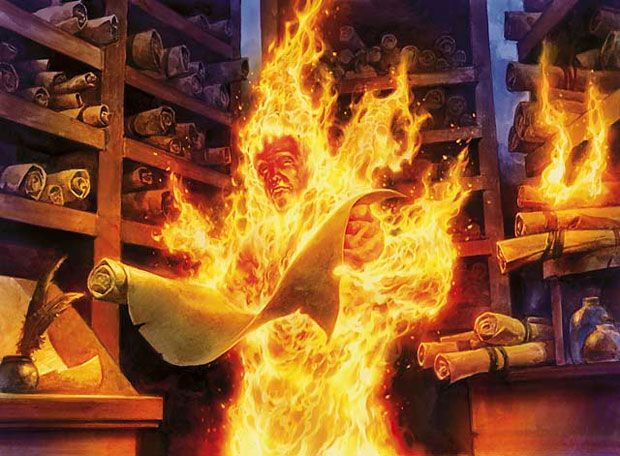
Let’s do this! Battle for Zendikar’s recent release on MTGO and Pro Tour BFZ coverage has me in a brewing mood, and I’ve been furiously sketching out decklists and searching for technology. Along the way, I’ve built a bunch of bad decks, which has been really informative as I’ve learned through trial by fire what works and what doesn’t. I’ve said before that Modern (and Eternal formats in general) exists as a collection of powerful cards and effects kept in check by constraints. These constraints in combination with metagame information and archetype strengths/weaknesses are primarily responsible for influencing what decks/cards perform well week to week. So, today I’d like to take an analytical approach to context and apply this to Modern on a broad scale. Next week, (unless there's something more urgent to talk about) we’ll go more in-depth on this concept and look at constraints in Modern on a card-by-card basis. Let’s go!
[wp_ad_camp_1]
Context
Magic, at its core, is game of interactions and the exchange of resources. Sure, archetypes can have cohesive strategies that ignore this philosophy (like combo) but fundamentally interactions between individual cards drive card value (gameplay, not monetary), which extends to decks, which define metagames.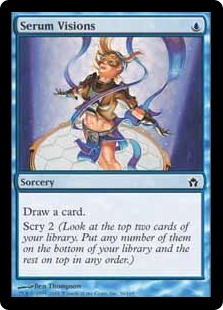 We see this in every game of Magic we play, regardless of format, but we might not think about it that often. Serum Visions trades a mana for library manipulation to be taken advantage of later, Doom Blade trades for Primeval Titan, gaining on mana efficiency but losing on overall cards (due to the Titan trigger). These dozens of interactions accrue over the course of a game until a winner is decided, and then the slate is wiped clean and we start over. Outside of certain game-breaking effects that ignore this principle (Splinter Twin to end the game immediately, Blood Moon against an opponent with all non-basics) most cards are included in decks because they either contribute to a general strategy or allow for favorable interactions.
We see this in every game of Magic we play, regardless of format, but we might not think about it that often. Serum Visions trades a mana for library manipulation to be taken advantage of later, Doom Blade trades for Primeval Titan, gaining on mana efficiency but losing on overall cards (due to the Titan trigger). These dozens of interactions accrue over the course of a game until a winner is decided, and then the slate is wiped clean and we start over. Outside of certain game-breaking effects that ignore this principle (Splinter Twin to end the game immediately, Blood Moon against an opponent with all non-basics) most cards are included in decks because they either contribute to a general strategy or allow for favorable interactions.
How certain cards line up against others contributes to their “worth” but doesn’t give the whole story. 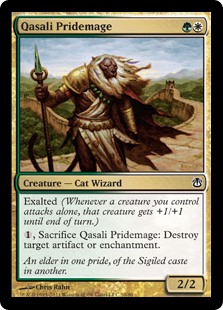 For example; Qasali Pridemage lines up poorly against Lightning Bolt (losing a mana on the exchange) but still sees a fair amount of play. Why? Artifact/Enchantment removal is not necessarily hard to come by in G/W, but attaching this interaction to a creature lets G/W execute its primary gameplan (playing and attacking with creatures) while also providing interaction without having to go off-plan for something like Stony Silence or Erase. The exalted ability helps as well to provide a synergistic “hate-card” that has a high floor and provides incidental interaction, even in the face of its inherent weakness to Lightning Bolt. This scenario is important to keep in mind, as it gives us an explanation for why cards like Fauna Shaman/Lotus Cobra don’t see much play while Qasali Pridemage does.
For example; Qasali Pridemage lines up poorly against Lightning Bolt (losing a mana on the exchange) but still sees a fair amount of play. Why? Artifact/Enchantment removal is not necessarily hard to come by in G/W, but attaching this interaction to a creature lets G/W execute its primary gameplan (playing and attacking with creatures) while also providing interaction without having to go off-plan for something like Stony Silence or Erase. The exalted ability helps as well to provide a synergistic “hate-card” that has a high floor and provides incidental interaction, even in the face of its inherent weakness to Lightning Bolt. This scenario is important to keep in mind, as it gives us an explanation for why cards like Fauna Shaman/Lotus Cobra don’t see much play while Qasali Pridemage does.
Taking this principle and applying it to commonly played cards, we can start to see a trend developing. Loxodon Smiter would normally be too underwhelming for three mana (and often is) but its 4/4 size, immunity to counterspells and interaction with Liliana of the Veil all contribute to push it over the line into playable range. Were Liliana of the Veil and Mana Leak to become omnipresent in Modern we would see Loxodon Smiter’s stock go up, and vice versa. Moving forward, if Loxodon Smiter hypothetically starts becoming a format staple, Lightning Bolt’s value (and decks that rely on Lightning Bolt as removal) would start to take a hit.
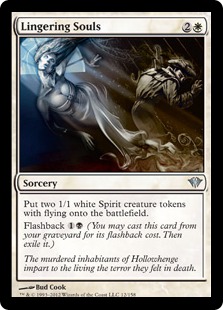 This card evaluation process is something almost every player takes into account, whether they are building decks or just playing games. The most common case is playing against counterspells. Experienced players can attest to leading with Lingering Souls instead of Liliana of the Veil in the face of open mana against a blue player. Why? Because Lingering Souls matches up more favorably against counterspells than Liliana of the Veil. Against Bogles, Liliana will more often than not be played first. Against Affinity, Lingering Souls is miles better. These individual interactions, when aggregated with the other cards in our deck against the format as a whole combine to form the baseline for matchup strengths and weaknesses.
This card evaluation process is something almost every player takes into account, whether they are building decks or just playing games. The most common case is playing against counterspells. Experienced players can attest to leading with Lingering Souls instead of Liliana of the Veil in the face of open mana against a blue player. Why? Because Lingering Souls matches up more favorably against counterspells than Liliana of the Veil. Against Bogles, Liliana will more often than not be played first. Against Affinity, Lingering Souls is miles better. These individual interactions, when aggregated with the other cards in our deck against the format as a whole combine to form the baseline for matchup strengths and weaknesses.
Matchup percentages, while often whimsical and unreliable, are based largely on the aggregate of these interactions. Take the Bant Knightfall vs. Grixis Control matchup. Loxodon Smiter makes Lightning Bolt, counterspells, and discarding with Kolaghan's Command extremely awkward. Geist of Saint Traft is almost impossible to remove if it can resolve, which is made possible through mana creatures and Voice of Resurgence making counterspells either too slow or a huge liability.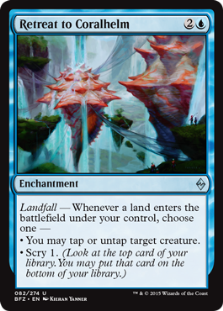 Retreat to Coralhelm just being an enchantment gives it inherent resiliency against Grixis once on the field, as they usually can’t do anything to remove it outside of Cryptic Command. Grixis’ gameplan of dropping quick delve creatures to block is punished heavily by Retreat to Coralhelm, Path to Exile, and Remand. Even Grixis’ primary strategy of trading resources and pulling ahead in the midgame with Kolaghan's Command lines up poorly with Bant Knightfall’s goal of applying quick pressure and leveraging tempo as a resource to keep the opponent on the back foot. Apply this thinking to your matchup of choice and you will start to see inherent strengths, weaknesses, under/overperforming card slots, and areas for potential improvement.
Retreat to Coralhelm just being an enchantment gives it inherent resiliency against Grixis once on the field, as they usually can’t do anything to remove it outside of Cryptic Command. Grixis’ gameplan of dropping quick delve creatures to block is punished heavily by Retreat to Coralhelm, Path to Exile, and Remand. Even Grixis’ primary strategy of trading resources and pulling ahead in the midgame with Kolaghan's Command lines up poorly with Bant Knightfall’s goal of applying quick pressure and leveraging tempo as a resource to keep the opponent on the back foot. Apply this thinking to your matchup of choice and you will start to see inherent strengths, weaknesses, under/overperforming card slots, and areas for potential improvement.
Continuing with the Grixis Control/Bant Knightfall matchup, our analysis has determined that it’s very difficult for Grixis to “control” our gameplan, as most of our threats line up favorably against their interactive elements. Assuming our Grixis opponent is aware of this as well, we can deduce that they will attempt to shift to their backup strategy; racing us with a quick Gurmag Angler or Tasigur, the Golden Fang. This is where what is colloquially referred to as “next-leveling” comes in; crafting our post-sideboard configuration to beat our opponent’s perceived angle of attack in the matchup. When looking at sideboard options, most players would turn to options like Spellskite or Kitchen Finks in an attempt to grind through removal, when it’s possible that spells like Dispel and Dismember would be better options. Strategically, Spellskite and Kitchen Finks are great cards against an opponent looking to trade resources, but contextually Dispel and Dismember are better post-board options. A strong case can be made for any combination of all four of those spells, but Dispel and Dismember directly challenge our opponent’s most potent path to victory, rather than providing us more strength in an area where we are already advantaged.
Analyzing the Context of Modern
As we discussed at the beginning of the article, Modern is a format defined primarily by constraints. In most cases, these constraints exist as individual cards or sets of similar cards that provide a unique effect or punish a particular element of the format. We’ll get into these individual constraints later, but here I want to focus on the metagame; the collective archetypal information that we can expect to face at any given event. Rather than giving a basic overview of what each deck is attempting to do I’m looking instead at what principles each archetype is employing and the pressures it places on the format as a whole. In terms of scope, we’ll be looking primarily at Tier 1/Tier 2 archetypes, with a focus on unique strategies (grouping similar strategies like Abzan/Jund and Elves/Merfolk).
Midrange (Abzan, Jund, Grixis Planeswalkers)
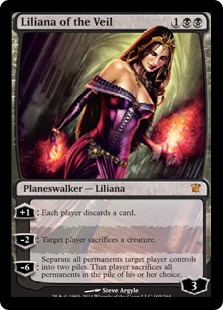 Characterized by cheap, efficient answers and high individual card quality, midrange strategies prey on synergistic archetypes through the power of discard spells and Liliana of the Veil. These decks mulligan well, employ powerful threats and broad answers, and focus on disruption, trading resources, and then topdecking better in the midgame. These strategies normally play a higher than average land count to support three colors and work their way up the curve to cast powerful 4/5 CMC spells and employ manlands to combat flooding. Midrange strategies have game against everything, and few slam-dunk matchups, but can be weak to dedicated combo and control strategies that have a natural resiliency to discard.
Characterized by cheap, efficient answers and high individual card quality, midrange strategies prey on synergistic archetypes through the power of discard spells and Liliana of the Veil. These decks mulligan well, employ powerful threats and broad answers, and focus on disruption, trading resources, and then topdecking better in the midgame. These strategies normally play a higher than average land count to support three colors and work their way up the curve to cast powerful 4/5 CMC spells and employ manlands to combat flooding. Midrange strategies have game against everything, and few slam-dunk matchups, but can be weak to dedicated combo and control strategies that have a natural resiliency to discard.
Hyper-Aggressive Aggro (Burn, Infect, Affinity)
These strategies seek to push a certain principle to the maximum, and can often be described as containing combo elements as a result.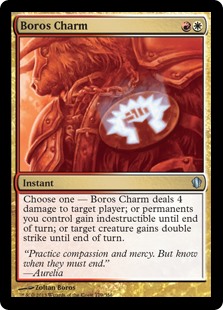 Burn seeks to assemble 6-7 cards that do 3-4 damage to an opponent, and takes advantage of widespread incidental fetch/shockland life loss. Infect employs individually weak creatures but pairs them with pumps spells and effectively “doubles-up” bonuses due to Infect’s benefit of having to only deal 10 damage. Affinity floods the board with cheap/free, individually weak artifacts and hopes to pair this with either 12 “payoff spells” or swarm an unprepared opponent. Archetypes like these capitalize on mana-efficiency, punish stumbling, force opponents off their lane and demand early interaction. They exist as the primary “stress-test” in the format, keeping crazy strategies in check and providing a ceiling to game length. Given enough time, Burn will eventually draw enough spells to finish off an opponent, so they have to try and end the game quickly. Hyper-Aggressive Aggro struggles against dedicated hate and as a result are often grouped with combo when evaluating deck choice for an event.
Burn seeks to assemble 6-7 cards that do 3-4 damage to an opponent, and takes advantage of widespread incidental fetch/shockland life loss. Infect employs individually weak creatures but pairs them with pumps spells and effectively “doubles-up” bonuses due to Infect’s benefit of having to only deal 10 damage. Affinity floods the board with cheap/free, individually weak artifacts and hopes to pair this with either 12 “payoff spells” or swarm an unprepared opponent. Archetypes like these capitalize on mana-efficiency, punish stumbling, force opponents off their lane and demand early interaction. They exist as the primary “stress-test” in the format, keeping crazy strategies in check and providing a ceiling to game length. Given enough time, Burn will eventually draw enough spells to finish off an opponent, so they have to try and end the game quickly. Hyper-Aggressive Aggro struggles against dedicated hate and as a result are often grouped with combo when evaluating deck choice for an event.
Combo (Splinter Twin, Living End, Tron, Scapeshift, etc)
 Combo decks attempt to ignore the principles of exchange in Modern, looking instead to end the game through an effect that goes over the top of everything else. Accruing value through Spell Snare on Tarmogoyfor Lightning Bolt against Kitchen Finks is irrelevant when you can attack for a million, flood the board with big creatures, or just cast gigantic spells until your opponent quits. Their combo element “payoff” either wins the game on the spot or puts the strategy far enough ahead that victory is assured, so the rest of their strategy is often focused on survival and consistency. These strategies punish non-interaction is a similar way to hyper-aggressive aggro, but choose to focus on consistency and incorporation of control elements rather than an “all-in” approach. The widespread combo options available in the format combined with the prevalence of strong hate cards creates a cat and mouse environment. Strategies that are forced to react (either because they are too slow or are looking to control) must prepare for some combo but cannot answer everything, which leads to interesting deck choices as players attempt to “dodge” hate by playing a different deck.
Combo decks attempt to ignore the principles of exchange in Modern, looking instead to end the game through an effect that goes over the top of everything else. Accruing value through Spell Snare on Tarmogoyfor Lightning Bolt against Kitchen Finks is irrelevant when you can attack for a million, flood the board with big creatures, or just cast gigantic spells until your opponent quits. Their combo element “payoff” either wins the game on the spot or puts the strategy far enough ahead that victory is assured, so the rest of their strategy is often focused on survival and consistency. These strategies punish non-interaction is a similar way to hyper-aggressive aggro, but choose to focus on consistency and incorporation of control elements rather than an “all-in” approach. The widespread combo options available in the format combined with the prevalence of strong hate cards creates a cat and mouse environment. Strategies that are forced to react (either because they are too slow or are looking to control) must prepare for some combo but cannot answer everything, which leads to interesting deck choices as players attempt to “dodge” hate by playing a different deck.
Control (Grixis, Jeskai, UW)
Control decks in Modern seek to win the same as every other control deck over the course of time; grind an opponent down to nothing and win through card advantage or some trump.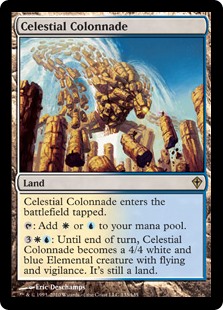 Kolaghan's Command rebuying Snapcaster Mage, Sphinx's Revelation and Celestial Colonnade, and Cryptic Command are all strong incentives to play reactively towards an endgame. Given the right build, Control wins by simply answering threats and staying alive to make land drops until the opponent starts flooding, at which point Control turns the corner and goes for the win. In Modern, Control exists as the natural ceiling to the midrange creep, as midrange matchups are normally slanted towards which deck is slightly bigger. This natural barrier combined with aggro’s mana efficiency keeps midrange decks honest, which is why we don’t see crazy things like Cruel Ultimatum and Sun Titan for value all the time. Control suffers from a weakness to discard, which can allow some decks to land a powerful threat that can go unanswered. In addition, the vast array of literal insanity that people play in Modern makes things difficult for a reactive strategy to have the right answers. Trying to prepare for Burn, Jund, Merfolk, Affinity, Scapeshift, Splinter Twin, Amulet Bloom, the mirror, and countless other decks can leave a control deck stretched too thin on answers. There just isn’t enough sideboard slots to prepare for everything.
Kolaghan's Command rebuying Snapcaster Mage, Sphinx's Revelation and Celestial Colonnade, and Cryptic Command are all strong incentives to play reactively towards an endgame. Given the right build, Control wins by simply answering threats and staying alive to make land drops until the opponent starts flooding, at which point Control turns the corner and goes for the win. In Modern, Control exists as the natural ceiling to the midrange creep, as midrange matchups are normally slanted towards which deck is slightly bigger. This natural barrier combined with aggro’s mana efficiency keeps midrange decks honest, which is why we don’t see crazy things like Cruel Ultimatum and Sun Titan for value all the time. Control suffers from a weakness to discard, which can allow some decks to land a powerful threat that can go unanswered. In addition, the vast array of literal insanity that people play in Modern makes things difficult for a reactive strategy to have the right answers. Trying to prepare for Burn, Jund, Merfolk, Affinity, Scapeshift, Splinter Twin, Amulet Bloom, the mirror, and countless other decks can leave a control deck stretched too thin on answers. There just isn’t enough sideboard slots to prepare for everything.
Many other decks exist in the format, of course, but these are the most polarizing in terms of both overall strategy and the type of answers that they demand. When evaluating new or even old decks, it’s always a good idea to look at the format as a whole and see both where your deck of choice sits on this spectrum and how it matches up against these major strategies. Four Color Gifts Loam might be doing some cool things, but if it is weak to aggro, can’t apply pressure fast enough to beat control, struggles against discard and can’t react well enough to fight combo, what are you really doing? Also, we’ve talked before about finding your role in Modern, and by this I mean making sure that we’re not a bad something else. Sliver Aggro as played by Adam Bowman at SCG Cincinnati is a cool, innovative deck, but functions too-similarly to Merfolk. This is fine by itself, but Merfolk does a lot of things better than Slivers which makes us wonder if we’re really gaining anything by playing Slivers or if we should just be playing Merfolk instead. This can be applied to many decks we’ve seen pop up before, like B/W Tokens, Vampires, Goblins, Soul Sisters, U/W Sun Titan, on and on it goes. Making a new deck is awesome, as we sometimes find gems like Amulet Bloom and Grishoalbrand, but these decks are successful because they have a solid foundation, can effectively answer many of the format’s stress tests, and are unique.
Conclusion
As I’ve become busier with school/other commitments, I haven’t been able to devote as much time to actually playing games of Magic anymore. While this can be seen as a negative, this has in a sense forced me to start thinking about Magic more analytically. Where before I would just grind some matches with a deck to determine how it plays in a matchup, I’ve found that just thinking through this process that I’ve outlined above can be far more helpful and efficient in terms of time for both increasing my Magic knowledge and ability and preparing for events. I encourage all of my readers to start thinking more analytically in terms of evaluating cards, decklists, tournament results and sideboarding. It requires a lot of effort upfront, and might not be as fun as just jamming some games, but for those looking to push their Magic ability to the next level I highly suggest practicing this process. One of the areas I struggle the most is sideboarding, both when building decks and playing matches. Thinking analytically about each archetype’s strengths/weaknesses, and then applying those characteristics to the matchup can result in some interesting discoveries (like the Spellskite/Dismember scenario above). If you’ve been stuck in a rut in terms of your Magic progression, you might be surprised where edges can be gained. If you enjoyed the content of this article or found it helpful, let me know what you think in the comments! If you think I got something wrong, I’d love to hear from you! As always, stop by my Twitch channel or Twitter feed and say hello! Thanks for reading, and I’ll see you next week.
Trevor Holmes
The_Architect on MTGO
Twitch.tv/Architect_Gaming
Twitter.com/7he4rchitect






Great article! This has me thinking more critically about my deck of choice, Podless Pod, in the context of why I would run it over another combo deck (namely Grixis Twin).
Speaking of which, how would you compare Eternal Witness in Podless Pod to Kolaghan’s Command with Snapcaster Mage in Grixis Twin?
I’m a relatively new reader, but I like what I’ve seen this far. Perhaps I’m too much of an idealist (or a hopeless romantic), but I get disappointed when I see the same decks over and over again. I’d love to see more decks that are reflections of their creators’ imaginations, rather than clones of other winning decks. They very popularity of the game, however, and often now the value of the prizes, drives many people to focus more on known commodities (in terms of decks) that have a history of success rather than interactions that make the game so endearing. We know what to sideboard in if we see _____. We know to run Dismember if good removal is not available in our color. I don’t know that I’d propose a bigger banned list, but wouldn’t it be nice to go into an event with no certainty you’d encounter [insert deck name or combo here]?
Modern has more viable tier 2 strategies than any other format in Magic, and you want to complain about it not being diverse enough? There are always going to be tier 1 decks that are generally better than all the other decks in the format, there’s no way to have a format where you wouldn’t expect to face some of those decks. This is how Magic always has been, and it’s how Magic always will be. If you don’t want to play against tier 1 decks, play casually with your friends instead of going to events.
I’m not complaining about playing against good decks. Rather, I’m lamenting those players who continually choose to play what others have created, rather than the diversity they could bring to the game.
For somebody who tries to act like you really truly understand Magic in general, and Modern specifically, you seem to have a relatively poor understanding of how decks function in Modern. Twin and Scapeshift are not combo decks, Burn and Infect are not aggro decks, control decks don’t just automatically win against the BG/x midrange decks, and in fact they frequently have poor matchups against those decks. Listen, I know you want to sound like you have this all-encompassing knowledge of Modern as a format, but there are so many incredibly wrong conclusions in this article that it’s hard to take you seriously.
I question someones knowledge of the format that would claim Scapeshift is not a combo deck. I think you are trying to argue Scapeshift is a control deck which is not the case, its a combo deck with control elements. It only seeks to stall until it can find and resolve a Scapeshift. It generally has few other win conditions in the first ame, though some lists run Inferno Titan or Prime Time. Scapeshift can also come in the form of Jund Scapeshift that trades blue for black discard and removal. The control elements and discard are just disruptive elements so that the deck can resolve the combo.
Splinter Twin is in fact a combo deck that takes many forms (Straight UR combo, midrange Grixis, and tempo UR/UR with Goyf). What’s the one thing those decks have in common? The splinter twin combo, which defines the deck. The control element, midrange element, and tempo element are supplementary back up plans in case the combo does not come together.
I don’t disagree infect can be classified as combo, but and burn also straddles the line between aggro and combo.
Also you didn’t seem to read the article very well because the author explicitly states that control suffers from a weakness to discard which undermines your critique that control straight beats GBx.
This post comes off as so opinionated that it misses the forest for the trees. Twin and Scapeshift are undeniably combo decks – they’re just not pure combo decks. Burn and Infect are aggressive strategies at their core, but they have some combo elements enabling them, and I’d even argue there’s a dash of tempo in there as well (Searing Blaze in Burn, for example). And how can you construe “Midrange has game against everything, but can at times be weak to combo and control” as “control automatically beats BGx”? If BGx fails to grind the control deck out of resources (as happens roughly half of the time, in my experience), it’s in big trouble, because the control deck tends to have superior inevitability. The fact that BGx can falter if this is the case doesn’t mean that it’s hopeless, though. It means that there’s a scenario in which BGx is clearly disfavored. Calm yourself down and read what he said again.
As far as the article goes, I think it’s fine, though I am disappointed that creature-based aggro, such as Elves (though this one has combo elements to it), Merfolk, and Zoo did not get discussed. This might have been because your versions of Knightfall thus far qualify as creature-based aggro with combo on the side, and thus you’d essentially be describing the mirror, but I think that discussing a strategic mirror has some merit to it, as I can attest that it can be a hard thing to get a hang of.